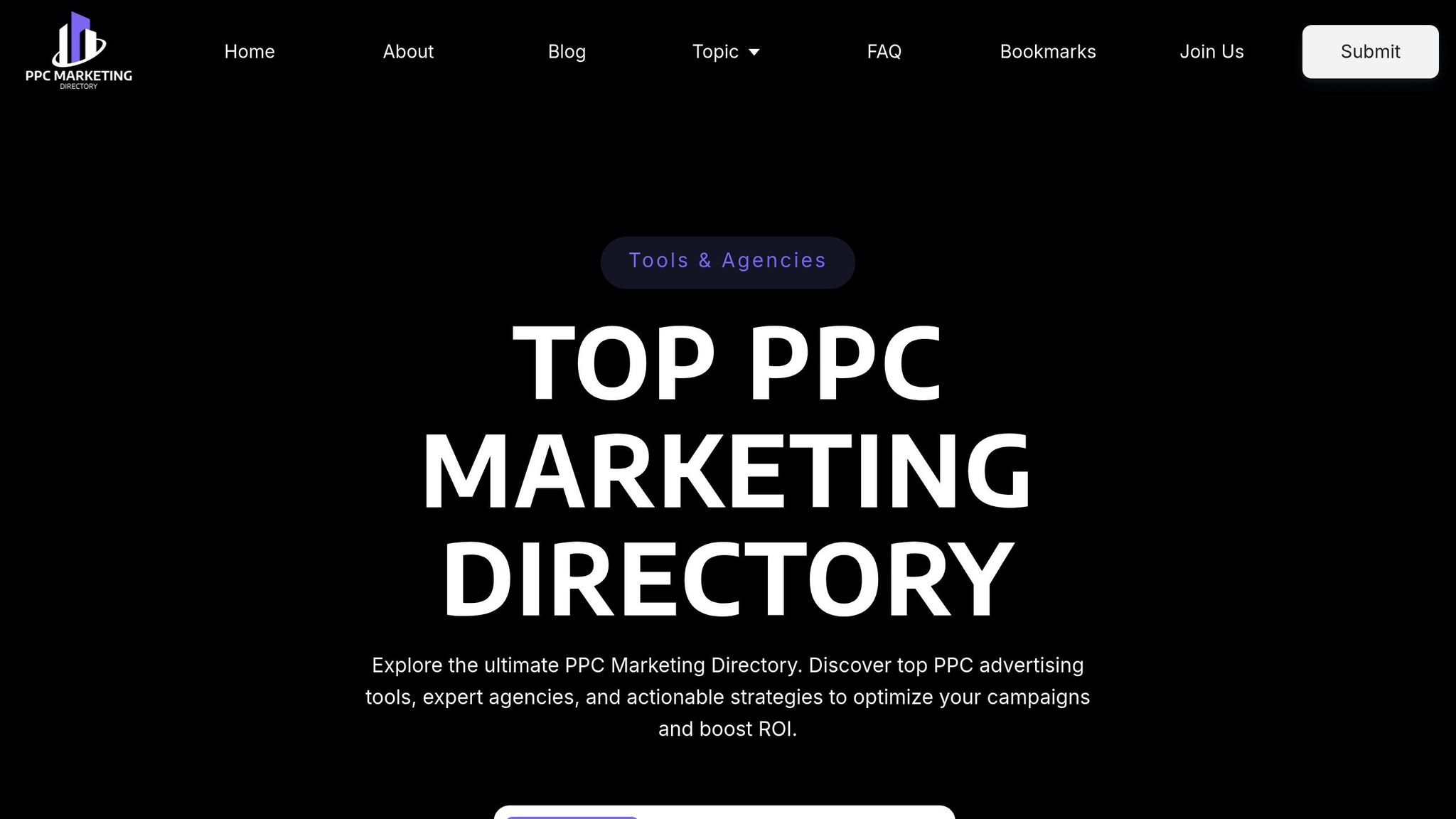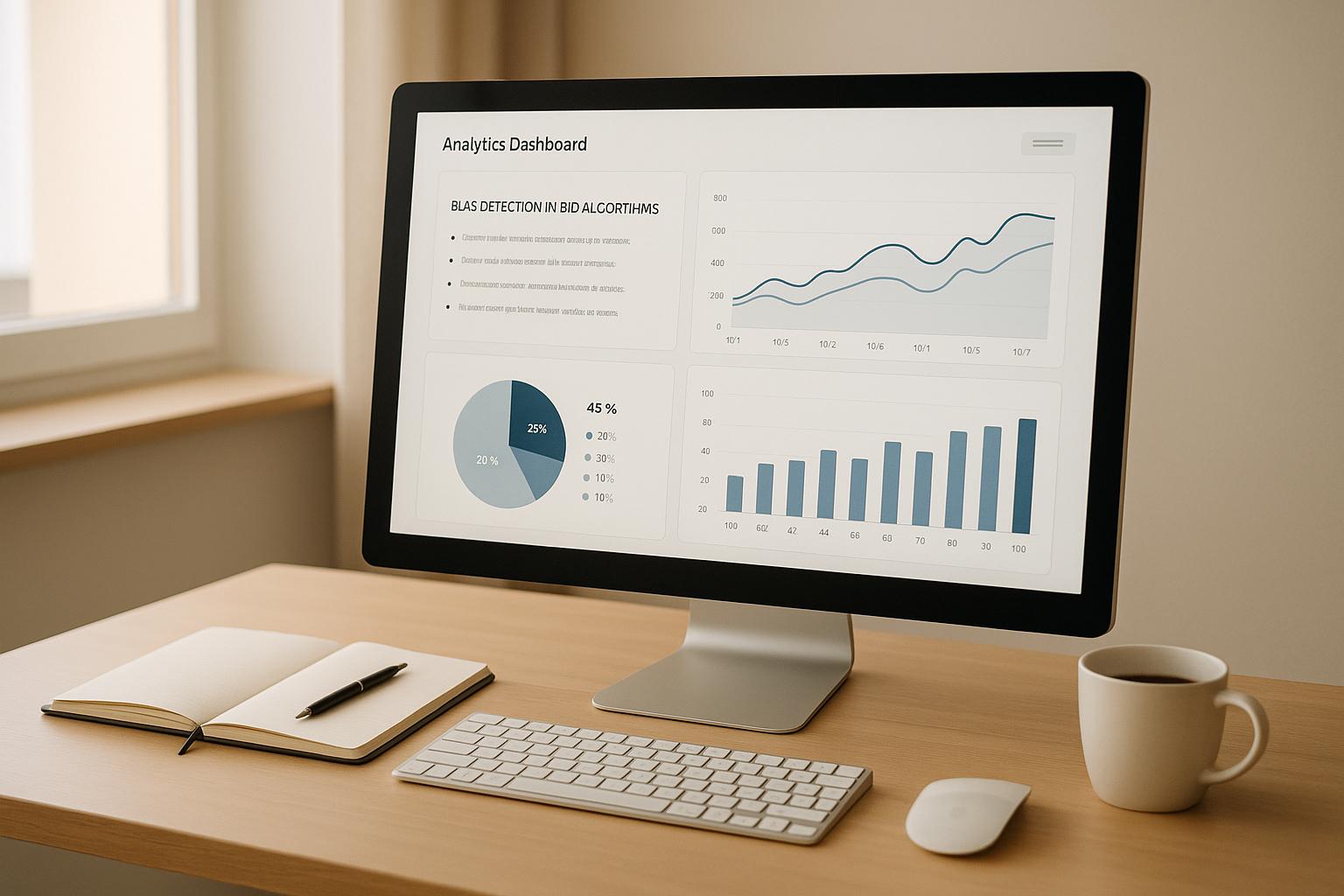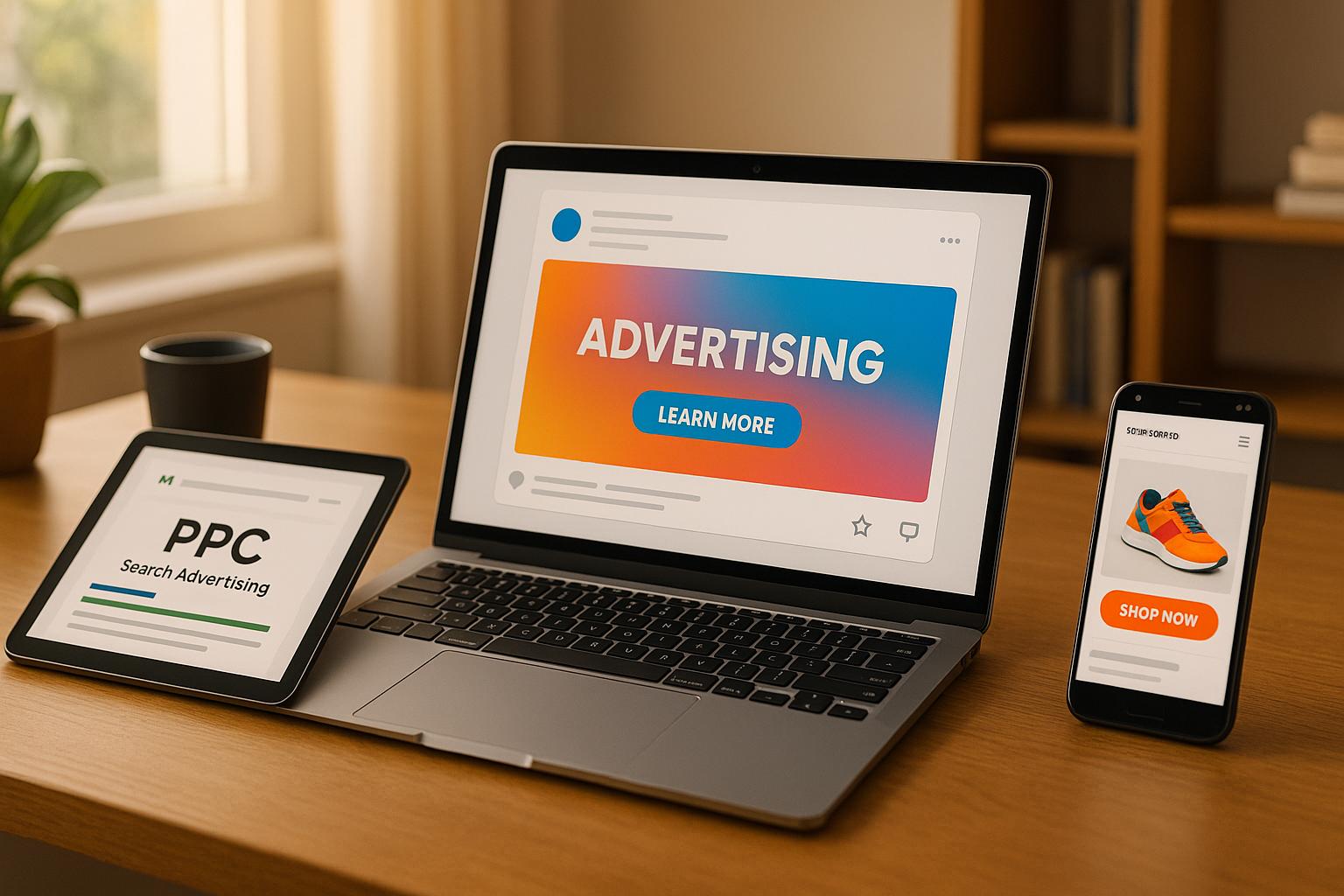Want to get more revenue from your ad spend? Here’s the key: allocate your budget strategically. Businesses that focus on high-performing campaigns and platforms often achieve a 4:1 ROAS or higher, while others leave revenue on the table. The secret lies in:
- Choosing the right platforms: Use Google Ads for high-intent searches, Facebook for broad audiences, and LinkedIn for B2B connections.
- Adjusting based on performance data: Reallocate 15–20% of ad spend to top-performing campaigns for better results.
- Tracking ROAS and CPA together: Understand how much you’re earning vs. spending to acquire customers.
To succeed, calculate your break-even ROAS, optimize budgets gradually, and monitor key metrics like conversion rates and customer acquisition costs. Tools like SEMrush or Optmyzr can help manage campaigns efficiently. Smart adjustments and regular reviews will ensure every dollar works harder for you.
ROAS Dropping When You Increase Ad Spend? DO THIS
Understanding ROAS and Its Impact on Campaign Success
ROAS, or Return on Ad Spend, is a key metric that shows how effectively your advertising dollars are performing. In simple terms, it measures how much revenue you earn for every dollar spent on advertising. It's a straightforward way to see if your ads are paying off.
What ROAS Is and How to Calculate It
The formula for ROAS is:
ROAS = Revenue attributable to ads / Cost of ads
You can represent ROAS as a ratio (e.g., 3:1) or as a percentage (e.g., 300%).
Here’s an example: Imagine a company spends $5,000 on ads in a month and generates $25,000 in revenue. Divide the revenue by the ad spend, and you get a 5:1 ROAS. This means every dollar spent on ads brought back $5 in revenue.
When calculating ROAS, make sure to include all associated costs - vendor fees, team salaries, affiliate commissions, and anything else tied to running the campaign. Ignoring these costs can artificially inflate your ROAS and lead to poor budgeting decisions.
A commonly accepted benchmark for ROAS is around 4:1, though many businesses aim for a range of 3:1 to 4:1. To get the most out of this metric, track ROAS across different levels - such as campaigns, channels, and platforms - and set a minimum acceptable ROAS before launching any campaign.
This metric provides a solid foundation for balancing other critical advertising KPIs.
How ROAS and CPA Work Together
ROAS becomes even more powerful when paired with CPA (Cost Per Acquisition). While CPA focuses on how much you’re spending to acquire each customer, ROAS puts that into perspective by showing how much revenue those customers generate. Together, these metrics guide decisions on budget allocation and automated bidding strategies.
For instance, CPA is particularly useful for campaigns aimed at building brand awareness, testing new channels, or running limited-time promotions. On the other hand, ROAS shines in e-commerce, direct-response campaigns, and during competitive seasons when maximizing revenue is critical.
Setting Your Target ROAS
The right target ROAS depends on your business model and profit margins. A good starting point is a minimum target of 200% ROAS, with most businesses aiming for a range between 400% and 800%. Your target should align with your overall goals and take factors like your business stage, seasonal peaks, and product lifecycle into account. For example, startups might accept lower ROAS during market testing, while established brands often aim for higher returns.
Allocating Ad Spend Based on Business Goals
When it comes to dividing your ad budget, it’s all about letting your business goals and performance data steer the ship. Whether you’re looking to generate leads, boost e-commerce sales, or build brand awareness, your spending should align with those objectives.
Matching Ad Budgets with Business Goals
Different goals require different spending strategies:
- Lead generation campaigns thrive on steady, consistent investment to keep a flow of potential customers coming in. For example, if your goal is 500 qualified leads per month, calculate your spend based on your target cost per lead.
- E-commerce sales campaigns typically see the best results when budgets are increased during key shopping seasons or product launches. These campaigns often focus on bottom-of-funnel efforts, where customers are ready to make a purchase.
- Brand awareness campaigns aim for a wider audience reach and may accept lower short-term returns in exchange for long-term recognition.
"Understanding the client's objectives - increasing brand awareness, driving app downloads, or boosting sales - helps ensure that every dollar spent pushes toward those targets".
A balanced budget across multiple channels can safeguard against unexpected changes. Setting SMART goals (Specific, Measurable, Achievable, Relevant, Time-bound) is crucial for effective spending. For instance, instead of aiming to "increase sales", a SMART goal would be: "boost online sales by 25% in the next quarter through targeted campaigns on Facebook and Google."
Once your goals are clear, use performance data to refine your strategy.
Using Performance Data for Budget Decisions
Performance data is your best friend when it comes to fine-tuning your ad spend. While 79% of marketers focus on lead generation, a surprising 34.2% admit their company rarely or never measures ROI. Without tracking ROI, it’s impossible to know if your budget is working effectively.
"KPIs are important to clients because they want to understand how much they are spending, what they are spending it on and most importantly, what is the return on their spend. They also want to be able to measure the progress of the marketing campaigns month over month" - Jacob Hicks, Magnyfi.
Key metrics to monitor include:
- Website traffic and its sources
- Conversion rates
- Bounce rates
- Click-through rates
- Customer acquisition cost (CAC)
- Customer lifetime value (CLV)
- Average order value (AOV)
- Cart abandonment rates
Compare your campaign results with industry benchmarks and use A/B testing to optimize your ads. When you identify top-performing ads, shift more budget toward them while scaling back on underperforming ones.
"Analyzing paid ad performance ensures your budget delivers measurable outcomes rather than guesswork" - Glorywebs.com.
Additionally, refine your targeting by zeroing in on high-converting audience segments. This not only reduces costs but also improves your ROI by focusing on the platforms and placements that deliver the best results.
Calculating Break-Even ROAS
Once your goals and performance data are in place, it’s time to calculate your break-even ROAS (Return on Ad Spend). This metric is the bare minimum your campaign needs to generate to cover its costs. In simple terms, it’s when the revenue from your campaign equals your ad spend, meaning you’re not losing money - but you’re not making a profit yet either.
"The breakeven ROAS is the point at which the revenue generated by the campaign is equal to the cost of the advertising. In other words, it is the point at which the campaign is no longer losing money, but it is not yet generating a profit" - StoreHero.
Here’s how to calculate it:
- Formula 1: Revenue per product ÷ (Revenue per product – Total costs per product)
- Formula 2: 1 ÷ Average Net Profit Margin
For instance, if you sell a product for $100 and your total costs are $60, your break-even ROAS would be:
$100 ÷ ($100 - $60) = 2.5
This means you need $2.50 in revenue for every $1 spent on ads to break even.
Make sure you include all costs - like goods, shipping, fees, and overhead - when calculating your target ROAS. Many businesses mistakenly focus only on ad costs, which can make campaigns look successful on paper while actually being unprofitable. To keep things efficient, group products with similar profit margins into the same campaign to maintain a consistent cost-to-benefit ratio.
Methods to Optimize Ad Spend for Better ROAS
Once you’ve nailed down your break-even ROAS and aligned your budget with your business goals, the next step is making every advertising dollar count. By using the right strategies, you can ensure your ad spend delivers maximum returns.
Gradual Budget Scaling
One common mistake advertisers make is ramping up their budgets too quickly. This can cause ROAS to plummet by as much as 40–70%. Instead, a gradual approach works best. By increasing ad spend incrementally - around 20–30% every 3–5 days - you allow ad platforms to adjust their algorithms for more efficient delivery.
Here’s how to scale effectively:
- Keep detailed records of your baseline performance, including ROAS, cost per acquisition, conversion rates, and audience sizes.
- Set minimum ROAS thresholds to know when to pull back if performance dips during scaling.
- Alternate between increasing budgets and expanding your audience to give platforms time to adapt.
- Time your scaling during periods of lower competition, when CPMs are typically cheaper.
This approach may take longer - doubling your ad spend while maintaining ROAS could take 4–8 weeks - but it’s worth the patience. Once your budgets are scaled, reallocating funds between campaigns can further amplify results.
Moving Budgets Between Campaigns
After scaling, the next step is reallocating funds from underperforming campaigns to those driving better results. This strategy helps boost ROAS without increasing your overall budget. Start by reviewing metrics at a granular level - look at individual campaigns, ad sets, and audience segments. Pause ads that aren’t performing well and shift that spend toward campaigns delivering stronger returns.
To make the most of this tactic:
- Use tools like Facebook’s Campaign Budget Optimization or Google’s Portfolio Bidding to automatically allocate more budget to your top-performing campaigns.
- Focus on audience segments that consistently deliver higher conversion rates and long-term customer value.
- Test small budget shifts - around 10–15% - from weaker campaigns, and monitor results for a week before making further adjustments.
For instance, BYLT’s app-based program saw a 35% increase in customer lifetime value after redirecting ad spend toward targeting existing customers.
Dayparting and Automated Bidding Methods
Timing your ads properly can make a huge difference. Dayparting ensures your ads run during the hours when your target audience is most active and ready to convert. For example, skipping early morning hours when conversion rates tend to be low can save costs - a strategy highlighted by Hilary Sperley, Performance Marketing Manager at HawkSEM.
To optimize your ad timing:
- Increase keyword bids during peak hours to capture high-quality traffic.
- Apply bid adjustments to eliminate low-performing hours, using a -100% adjustment during those times.
- Allocate more budget during high-conversion windows instead of spreading it evenly throughout the day.
Smart Bidding strategies, like Target ROAS, take this a step further. By using AI and machine learning, these tools adjust bids in real time to maximize conversion value. If your conversions have varying values or you’re aiming for a specific ROAS, Target ROAS bidding can help meet those goals.
Real-world examples show how impactful these strategies can be. KitchenLab, a premium kitchenware brand, increased its ROAS by 46% and cut advertising costs by 35% in just three months by focusing on its most profitable products and refining its bidding approach. Similarly, a pest control retailer achieved a staggering 451% ROAS boost on Google Shopping ads, while a New York-based fashion brand improved its campaign ROAS by 25% by tweaking product titles to lower CPC and drive more conversions.
sbb-itb-89b8f36
Tools and Resources for Ad Spend Management
Effectively managing ad spend requires the right tools to track performance and fine-tune campaigns. With businesses pouring $260 billion into PPC ads in 2023, having dependable tools for analytics and management is crucial to staying competitive.
Campaign Management Tools
Successful ad spend starts with robust campaign management tools that deliver detailed insights into your advertising efforts. The best PPC software includes features like in-depth analysis, AI-powered insights, cross-platform integration, customizable reports, and competitor benchmarking.
AI-driven PPC tools have become game-changers, reducing cost-per-click (CPC) by as much as 20–30%. These tools leverage machine learning to uncover patterns in your data that might otherwise go unnoticed, helping you make smarter decisions about where to allocate your budget.
When choosing a tool, it’s important to identify your priorities upfront. Are you looking for click fraud protection, competitor insights, or automated budgeting? Your specific goals will determine which features matter most. For instance, click fraud prevention is critical - ClickCease reports that 14% of PPC clicks are fake, costing advertisers billions.
Here are some popular tools and their pricing:
- SEMrush: Offers competitor analysis, ad creation, and campaign management starting at $129/month.
- SpyFu: Specializes in competitor research, revealing ad spend, keywords, and performance starting at $39/month.
- Optmyzr: Automates tasks and provides custom scripts for campaign management, starting at $249/month.
- Google Ads Editor: A free tool for managing large-scale PPC campaigns.
- WordStream: Provides keyword research, bid management, and performance reporting with custom pricing.
Balancing cost and value is key. Consider scalability and watch out for hidden costs. Free trials or demos can help you test usability and features before making a commitment.
These tools not only improve campaign performance but also assist in selecting expert agencies, which we’ll explore next.
Using the Top PPC Marketing Directory

The Top PPC Marketing Directory is an excellent resource for businesses looking to maximize their ad spend. It connects you with leading PPC tools, expert agencies, and services for tasks like bid and keyword research, ad copy optimization, A/B testing, retargeting, and performance tracking.
What sets this directory apart is its ability to streamline your search. Instead of spending weeks researching, you can explore detailed agency profiles and case studies to find partners that align with your goals. The directory allows you to filter by expertise, budget, location, and client reviews, helping you identify agencies that deliver measurable results, such as a 40% revenue increase or a 25% boost in conversion rates.
For example, agencies like Traffic Dojo have earned rave reviews, with clients reporting a 40% revenue increase and a 25% rise in conversion rates. Similarly, Intero Digital has helped businesses achieve a 20% revenue increase through strategic PPC management.
Other standout agencies include KlientBoost, known for its data-driven approach and responsiveness, with 90% of reviews highlighting their ability to boost ROI. For those seeking comprehensive solutions, Single Grain has been praised by 100% of reviewers for improving CPC and ROAS efficiency.
Comparing Resources for Optimization
Combining powerful tools with expert agency support is a winning formula for optimizing ad spend. When evaluating tools and services, prioritize features like campaign analytics, A/B testing, and retargeting. The Top PPC Marketing Directory simplifies this process by offering curated options tailored to your needs.
For example:
- Databox: Ideal for managing campaigns across multiple channels with its centralized, user-friendly interface.
- SEMrush: An all-in-one platform with a strong focus on competitor analysis.
- SpyFu: Best for in-depth competitor research.
- Optmyzr: Specializes in AI-powered PPC optimization.
"PPC in 2025 is about more than just managing campaigns – it's about mastering the ecosystem around them." - Aric Whiteley, Co-founder and Managing Director at Lockhern Digital
To get the most out of these tools, regularly analyze campaign performance by tracking key metrics like CPC, ROAS, and CTR. Then, use the data to refine your strategy. With businesses earning an average of $2 in revenue for every dollar spent on Google Ads, the right tools and expertise can make a huge difference.
Finally, consider that 76% of marketing budgets are wasted. Choosing the right resources can help you avoid common pitfalls and ensure your ad spend delivers results. Whether you need automated bid management, detailed reporting, or expert guidance, focus on solutions that align with your goals and budget.
Measuring and Adjusting for Better ROAS Over Time
Improving your return on ad spend (ROAS) isn’t a one-and-done task. It’s an ongoing process that requires consistent monitoring, smart adjustments, and a willingness to adapt based on data. The best advertisers are always refining their strategies to get the most out of their budgets.
Setting Up a Regular Review Process
Establish a clear review schedule - whether weekly or monthly - to stay on top of your campaign performance. This allows you to quickly spot underperforming areas and seize new opportunities. Use real-time tracking tools to monitor campaigns and make immediate changes when needed. For example, if you notice an ad isn’t delivering results, you can tweak the bid, messaging, or creative assets right away to prevent wasting your budget.
Dive deep into performance metrics at every level - campaign, ad group, and individual ad. Look for patterns or trends that can guide your decisions. Maybe certain ad groups perform better during specific times of the day, or perhaps particular creative formats generate higher conversion rates. Set up alerts for critical metrics like a drop in ROAS, a spike in CPC, or a decline in conversion rates to stay ahead of potential issues.
"Mastering ROAS is not merely about optimizing a single metric - it's about establishing an ecosystem where data-driven insights, tactical adjustments, and continuous improvement are the norm." - Sarah Lee, Author
Once you’ve established a consistent review process, advanced attribution models can help you refine your strategy even further.
Using Data-Driven Attribution Models
Data-driven attribution (DDA) takes a detailed look at the customer journey, using algorithms to assign credit to various touchpoints based on their actual contribution to conversions. This approach gives you a clearer picture of what’s working and where to allocate your budget for maximum impact.
Unlike traditional models that rely on fixed rules, DDA evaluates the real influence of each touchpoint. This allows you to pinpoint the most effective marketing channels and make smarter budget decisions. To get started, ensure you’re working with clean and comprehensive data. Tools like Google Analytics 4 can provide actionable insights, including cross-channel attribution data that highlights how different platforms complement each other.
Compare channel and keyword performance using different attribution models. Identify high-performing channels with strong ROAS and low cost per conversion, and consider shifting more budget there. At the same time, reduce spending on channels that aren’t delivering. To make the most of DDA, maintain good data hygiene - define conversions clearly, use consistent UTM parameters, and review your data regularly to catch and fix any issues.
With these insights in hand, you can confidently reallocate your budget to maximize your ROAS.
Dynamic Budget Reallocation
Dynamic budget reallocation is all about moving funds from underperforming campaigns to those that are delivering better results. This strategy relies on real-time adjustments based on audience behavior and changing content trends.
A great example comes from Clorox. Over six months, the company used Optimize by Roundel™ to fine-tune their campaigns, combining AI-driven recommendations with manual monitoring. The result? A 54% lift in ROAS. Similarly, KSG Mobile, Inc. uses predictive lifetime value (LTV) models to forecast each campaign’s potential ROAS, helping guide their investment decisions.
Leverage tools like automated bidding and AI-driven platforms to make these adjustments in real time. Keep an eye on key metrics like CPC and ROAS, and use A/B testing to refine your ads. First-party data can also be a powerful resource for improving targeting and customizing campaigns based on the channel or season.
Before reallocating budgets, ensure you’ve collected enough performance data to make informed decisions.
"Allocating your budget across channels using attribution modeling is a dynamic and iterative process. By understanding the customer journey, selecting appropriate attribution models, and analyzing data effectively, you can make informed decisions about where to invest your marketing budget for optimal results." - Prayrak M., Associate Director, WPP Media
Conclusion: Key Points for Ad Spend Allocation
Effective ad spend allocation isn’t about throwing more money at campaigns - it’s about making smarter, more informed decisions. When done right, it can significantly improve your return on ad spend (ROAS) by focusing on data, regular testing, and strategic adjustments.
The foundation of better ROAS lies in data-driven decisions. Businesses that consistently analyze and optimize their ad budgets can see up to a 30% improvement in ROAS compared to those that stick to static budgets. This means diving deep into metrics like cost per acquisition, conversion rates, click-through rates, and overall ROAS to pinpoint what’s working - and what’s not.
Regular optimization is key to staying competitive, especially as market conditions evolve. For example, A/B testing alone can improve conversion rates by 15–25% on average, which directly impacts ROAS. Make it a habit to pause underperforming ads, experiment with fresh creatives, and shift budgets toward campaigns and platforms delivering the best results. Platforms with lower costs per conversion and higher returns should always get priority.
Refining audience targeting can have one of the biggest impacts on ROAS. Strategies like lookalike audiences, retargeting, and intent-based segmentation help focus your spend on high-value prospects. Automated tools and smart bidding strategies can further enhance efficiency by dynamically adjusting bids based on user behavior, saving time and improving results.
To make these adjustments easier, having the right tools is crucial. Platforms like the Top PPC Marketing Directory can help you find solutions for bid optimization, campaign management, and performance tracking. Access to expert tools and agencies simplifies the optimization process and ensures that every dollar is allocated effectively.
Ad spend allocation is not a one-time effort. Monthly reviews, along with weekly or even daily adjustments for fast-moving campaigns, help ensure budgets stay aligned with performance trends. By sticking to these data-focused strategies and leveraging automation where possible, you can stretch your ad dollars further and achieve lasting improvements in ROAS.
FAQs
How do I choose the best platforms to allocate my ad budget for the highest ROAS?
To make the most of your ad budget and boost your Return on Ad Spend (ROAS), focus on the platforms where your audience is most active and engaged. Platforms like Google Ads, YouTube Ads, and Facebook Ads are popular choices because they offer a wide reach and deliver strong results across many industries. If you're running B2B campaigns, consider LinkedIn and Microsoft Advertising for their precise targeting capabilities.
Take the time to align your campaign goals, audience behavior, and budget with the right platforms. Keep a close eye on performance metrics and adjust your strategy as needed, reallocating funds to the channels that deliver the best results. A data-driven approach ensures your ad spend works harder for you.
What are the best ways to scale my ad budget without hurting ROAS?
To grow your ad budget without hurting your ROAS, it’s essential to take it slow. Aim for gradual increases - around 15–20% every few days. Jumping too quickly can throw off your campaign’s performance, so small, steady adjustments work best.
Prioritize scaling campaigns that are already delivering great results. Dig into your data to pinpoint the audiences, keywords, and ad creatives that are performing well. Double down on these while mixing in fresh, diverse creative assets to keep your audience interested and engaged.
Keep a close eye on your performance metrics to make sure your tweaks are paying off. Regular monitoring and fine-tuning will help you maintain a healthy ROAS as you expand your ad spend.
What is break-even ROAS, and how can I use it to allocate my ad budget effectively?
What Is Break-even ROAS?
Break-even ROAS (Return on Ad Spend) is the baseline ROAS you need to hit just to cover your costs - no profits, no losses. The formula is simple: divide your total ad costs by your profit margin.
Here’s an example: Let’s say your profit margin is 50%, and you spend $1,000 on ads. To break even, your ROAS needs to be 2:1 (or 200%). This means you’d need $2,000 in revenue to offset your $1,000 ad spend.
Why does this matter? Knowing your break-even ROAS is like having a compass for your ad budget. It shows you which campaigns are worth doubling down on. If your actual ROAS is above the break-even point, congratulations - your ads are profitable. That’s your green light to scale up those winning campaigns.


